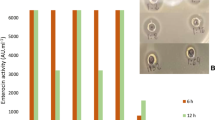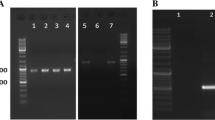Abstract
This study was focused on screening the most frequently occurring enterocin (Ents) genes in faecal enterococci from the Pannon White breed of rabbits, in which this parameter never has been tested. Enterococci tested were Ent genes absent, except Enterococcus faecium EF9a, which possessed genes for four Ents. Strains produced a high amount of lactic acid (1.25 ± 0.055 mmol/L, on average) and sufficiently tolerate bile. Inhibition activity of crude bacteriocin substance—partially purified (Ent, CE EF9a)—was tested against altogether 53 indicator strains. The growth of 38 strains of different staphylococcal species was not inhibited. However, the growth of fifteen other Gram-positive indicators was inhibited with inhibition activity ranged from 100 to 12,800 AU/mL. Listeria monocytogenes LM 7562 was the most susceptible to CE EF9a treatment (12,800 AU/mL). Molecular mass of CE EF9a ranged between 3000 and 10,000 Da. After heat treatment at different temperatures and time, CE EF9a was active with the inhibition activity 12,800 AU/mL. After storage of CE EF9a at different conditions, it was active even after 2-month storage at room temperature (200 AU/mL against LM 7562 strain). Inhibition activity of CE EF9a after 2-month storage at 4 °C was 1600 AU/mL and the most stable was CE EF9a at − 20 °C; the activity 12,800 AU/mL was kept still after 2 months. It indicates a small, thermostable substance; however, in further detail, purification analysis is necessary.
Similar content being viewed by others
Data Availability
The datasets used and/or analyzed during the current study are available from the corresponding author on reasonable request.
References
Kayser FH (2003) Safety aspects of enterococci from the medical point of view. Int J Food Microbiol 88:255–262. https://doi.org/10.1016/S0168-1605(03)00188
Linaje J, Coloma MD, Pérez-Martínez G, Zuniga M (2004) Characterization of faecal enterococci from rabbits for selection of probiotic strains. J Appl Microbiol 96:761–771. https://doi.org/10.1111/j.1365-2672.2004.02191.x
Foulquié Moreno MR, Sarantinopoulos P, Tsakalidou E, De Vuyst L (2006) The role and application of enterococci in food and health. Int J Food Microbiol 106:1–24. https://doi.org/10.1016/j.ijfoodmicro2005.06.026
Franz CHMAP, van Belkum MJ, Holzapfel W, Abriouel H, Gálvez A (2007) Diversity of enterococcal bacteriocins and their grouping in a new classification scheme. FEMS Microbiol Rev 31:293–307. https://doi.org/10.1111/j.1574-6976.2007.00064.x
Nes IF, Diep D, Ike Y (2014) Enterococcal bacteriocins and antimicrobial proteins that contribute to niche control. In: Gilmore MS, Clewel DB, Ike Y et al (eds) In Enterococci: from commensals to leading causes of drug resistant infection [Internet] eds. Massachusetts Eye and Ear Infirmary, Boston, p 21 https://www.ncbi.nlm.nih.govgov>book>NBK190428
Yang SC, Lin CH, Sung C, Fang JY (2014) Antibacterial activities of bacteriocins: application in foods and pharmaceuticals. Front Microbiol 5:241. https://doi.org/10.3389/fmicb.2014.00241
Cotter PD, Ross RP, Hill C (2013) Bacteriocins-a viable alternative to antibiotics? Nat Rev Microbiol 11:95–105. https://doi.org/10.1038/nrmicro2937
Pogány Simonová M, Lauková A, Chrastinová Ľ, Strompfová V, Faix Š, Vasilková Z, Ondruška Ľ, Jurčík R, Rafay J (2009) Enterococcus faecium CCM 7420, a bacteriocin PPB 7420 and their effect in the digestive tract of rabbits. Czech J Anim Sci 54:376–386. https://doi.org/10.5219/213
Pogány Simonová M, Lauková A, Plachá I, Čobanová K, Strompfová V, Szabóová R, Chrastinová Ľ (2013) Can enterocins affect phagocytosis and glutathione-peroxidase in rabbits? Cent Eur J Biol 8:730–734
Sahl HG, Bierbaum G (1998) Lantibiotics: biosynthesis and biological activities of uniquely modified peptides from gram-positive bacteria. Annu Rev Microbiol 52:41–79. https://doi.org/10.1146/annurev.micro.52.1.41
Chen H, Hoover DG (2003) Bacteriocins and their food applications. Compr Rev Food Sci Food Saf 2:82–99 http://www.ift.org/publications/crfsfs
Lauková A, Strompfová V, Szabóová R, Bónai A, Matics ZS, Kovács M, Pogány Simonová M (2019) Enterococci from Pannon White rabbits: detection, identification, biofilm and screening for virulence factors. World Rabbit Sci 27:31–39. https://doi.org/10.4995/wrs.2019.10875
Bruker Daltonics Biotyper 2.0.2011. Software for microorganisms identification and classification user manual In http://mass-spec.lsu.edu/wiki/index.php/Infrared-MALDI on 2011-07-24
Woodford N, Egelton MC, Morrison D (1997) Comparison of PCR with phenotypic methods for the speciation of enterococci. Plenum Press New York 47:405–409. https://doi.org/10.1007/978-1-4899-1825-397
Lauková A, Bino E, Ščerbová J (2019) Domestic fowl of ducks, a source of faecal bioactive Enterococcus hirae strains. Polish. J Vet Sci 22:505–512. https://doi.org/10.24425/pjvs.2019.129958
Gilliland SE, Walker K (1990) Factors to consider when selecting a culture of Lactobacillus acidophilus as a dietary adjunct to produce a hypocholesterolemic effect in human. J Dairy Sci 73:905–911. https://doi.org/10.3168/jds.S0022-0302(90)78747-4
Strompfová V, Lauková A, Simonová M, Marciňáková M (2008) Occurrence of the structural enterocin A, P, B, L50B genes in enterococci of different origin. Vet Microbiol 132:293–301. https://doi.org/10.1016/j.vetmic.2008.05.001
Aymerich T, Holo H, Havarstain LS, Hugas M, Garriga M, Nes IF (1996) Biochemical and genetic characterization of enterocin A from Enterococcus faecium, a new antilisterial bacteriocin in the pediocin family of bacteriocins. Appl Environ Microbiol 62:1676–1682
Casaus P, Nilsen T, Cintas LM, Nes IF, Hernandez PE, Holo H (1997) Enterocin B, a new bacteriocin from Enterococcus faecium T136 which can act synergistically with enterocin A. Microbiology 143:2287–2294. https://doi.org/10.1099/00221287-143-7-2287
Cintas LM, Casaus P, Havarstein LS, Hernándéz PE, Nes IF (1997) Biochemical and genetic characterization of enterocin P, a novel sec-dependent bacteriocin from Enterococcus faecium P13 with a broad antimicrobial spectrum. Appl Environ Microbiol 63:4321–4330
Cintas LM, Casaus P, Holo H, Hernandez PE, Nes IF, Havarstein LS (1998) Enterocins L50A and L50B, two novel bacteriocins from Enterococcus faecium L50 are related to staphylococcal haemolysins. J Bacteriol 180:1988–1994
Baele M, Chiers K, Devriese LA, Smith HE, Wisselink HJ, Vaneechoutte M, Haesebrouck F (2001) The gram- positive tonsillar and nasal flora of piglets before and after weaning. J Appl Microbiol 91:997–1003. https://doi.org/10.1046/j.1365-2672.2001.01463
Mareková M, Lauková A, De Vuyst L, Skaugen M, Nes IF (2003) Partial characterization of bacteriocins produced by environmental strain Enterococcus faecium EK13. J Appl Microbiol 94:523–530. https://doi.org/10.1046/j.1365-2672.2003.01861.x
De Vuyst L, Callewaert R, Pot B (1996) Characterization of antagonistic activity of Lactobacillus amylovorus DCE471 and large-scale isolation of its bacteriocin amylovorin L471. Syst Appl Microbiol 19:9–20. https://doi.org/10.1016/S0723-2020(96)80003-8
Drider D, Bendali F, Naghmouchi K, Chikindas ML (2016) Bacteriocins: not only antibacterial agents. Probiotics Antimicrob Proteins 8:177–182. https://doi.org/10.1007/s12602-016-9223-0
Simonová M, Lauková A (2007) Bacteriocin activity of enterococci from rabbits. Vet Res Commun 31:143–152. https://doi.org/10.1007/s11259-006-3411-4
Cintas LM, Casaus P, Herranz C, Havarstein LS, Holo H, Hernández PE, Nes IF (2000) Biochemical and genetic evidence that Enterococcus faecium L50 produces Enterocins L50A and L50B, the sec-dependent Enterocin P, and a novel bacteriocin secreted without an N-terminal extension termed Enterocin Q. J Bacteriol 182:6806–6814. https://doi.org/10.1128/jb.182-23.6806-6814.2000
Criado R, Gutiérrez J, Martín M, Herranz C, Hernández PE, Cintas LM (2006) Immunochemical characterization of temperature-regulated production of Enterocin L50 (Ent L50A and Ent L50B), Enterocin P, and Enterocin Q by Enterococcus faecium L50. Appl Environ Microbiol 72:7634–7643. https://doi.org/10.1128/AEM.00983-06
Szabóová R, Lauková A, Pogány Simonová M, Strompfová V, Chrastinová Ľ (2012) Bacteriocin-producing enterococci from rabbits meat. Malaysian J Microbiol 8:211–218 ISSN 1823-8262
Strompfová V, Lauková A, Ouwehand AC (2004) Lactobacilli and enterococci-potential probiotics for dogs. Folia Microbiol 49:203–207. https://doi.org/10.1007/bf02931403
Pogány Simonová M, Lauková A, Chrastinová Ľ, Plachá I, Kandričáková A, Žitňan R, Strompfová V (2019) Selected strain Enterococus faecium EF9a from Pannon White rabbit used in Slovak broiler rabbits. In Book of abstracts, conference, power of microbes in industry and environment 2019, May 15-18, Hotel Spa Golfer, Sveti Martin na Muri, Croatia, p. 63.
Acknowledgements
The authors thank for the skillful assistance of Mrs. Margita Bodnárová. Preliminary results were presented as a poster at the Lagomorpha Conference in Vienna as well as at the 24th Hungarian Conference on Rabbit Production, 30 December 2012, Káposvár, Hungary (Lauková et al. 2012: Bacteriocin-producing microbiota isolated from Pannon White rabbits and their application in rabbit husbandry, 89–93). We thank our colleagues from Káposvár University for their help with faeces sampling—András Bónai, Zsolt Matics, and also Melinda Kovács for their effort in cooperation. Methods and results associated with identification have been already published in Worl Rabbit Sci 2019, 27, 31–39. DOI:https://doi.org/10.4995/wrs.2019.10875 (Lauková A, Strompfová V, Szabóová R, Bónai A, Matics Zs., Kovács M, Pogány Simonová M. Enterococci from Pannon White rabbits: detection, identification, biofilm and screening for virulence factors). Therefore, language was checked by a professional translator.
Funding
The results achieved were financially supported by the bilateral Slovak-Hungarian project APVV:SK-HU-0006-08 and partially by the project Vega 2/0006/2017.
Author information
Authors and Affiliations
Contributions
AL was the author of a scientific idea; she collected samples, summarized results, wrote the manuscript, and designed the project; MPS and VS treated samples to isolate microbiota and provided enterocin gene detection analysis. All authors approved the final manuscript and agree with its submission.
Corresponding author
Ethics declarations
Not applicable
Conflict of Interest
The authors declare that they have no conflicts of interest.
Consent for Publication
Not applicable.
Additional information
Publisher’s Note
Springer Nature remains neutral with regard to jurisdictional claims in published maps and institutional affiliations.
Rights and permissions
About this article
Cite this article
Lauková, A., Strompfová, V. & Simonová, M.P. Enterocin Structural Gene Screening in Enterococci from Pannon White Breed Rabbits. Probiotics & Antimicro. Prot. 12, 1246–1252 (2020). https://doi.org/10.1007/s12602-020-09641-y
Published:
Issue Date:
DOI: https://doi.org/10.1007/s12602-020-09641-y




